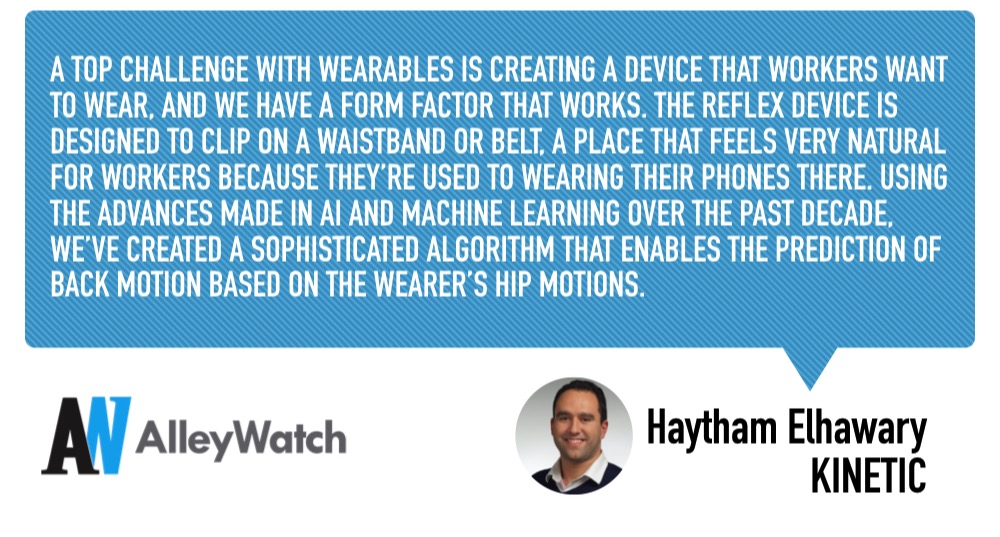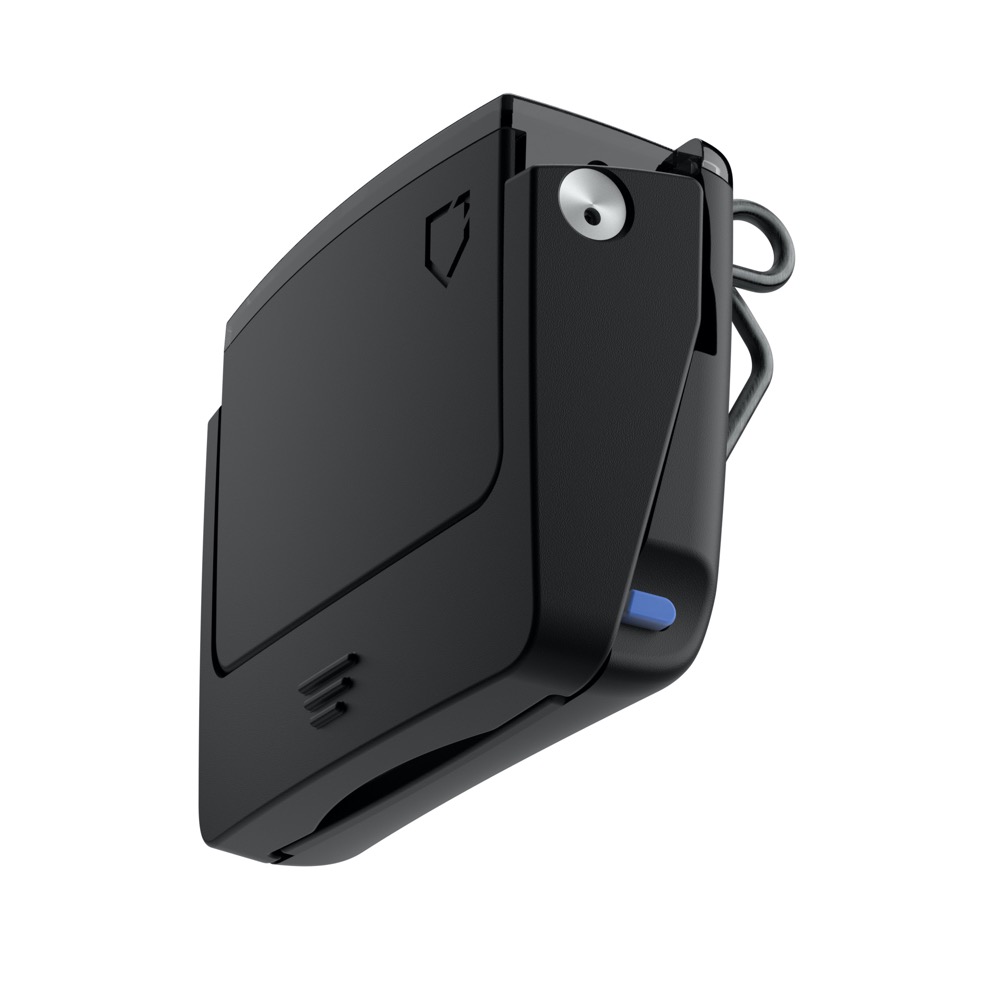Industrial companies are constantly seeking new ways to keep their workforces safe and KINETIC has been one of the key solutions. The company’s patented wearable device, Reflex, detects unsafe postures and provides real-time alerts to employees whenever they are engaging in high-risk motions. The company’s dashboard layers software so that managers and safety personnel can have a bird’s eye view into safety and incident data; now address workplace issues with a data-driven approach. Already used across a range of industries including 6 Fortune 50 companies, KINETIC has helped reduce workers’ compensation costs by 54% on average. The technology has also been used during the pandemic to ensure safe social distancing among employees and provide contact trading information.
AlleyWatch caught up with CEO and Cofounder Haytham Elhawary to learn about KINETIC’s technology is keeping workforces globally safe, how warehouses are able to leverage the technology, and the company’s recent funding round, which brings the total funding raised to $17.4M.
Who were your investors and how much did you raise?
KINETIC has secured an $11.25M Series A funding round led by Crosslink Capital, which had previously invested in the company, along with Primary Venture Partners and Nationwide Ventures. New investors include Prologis Ventures, the venture capital arm of Prologis, the global leader in logistics real estate, and Ubiquity Ventures, a venture firm focused on companies that bring “software beyond the screen.”
The new investment will help KINETIC grow and scale its engineering, sales, and marketing teams and support the development of the second generation of the KINETIC Reflex wearable device.
 Tell us about the product or service that KINETIC offers.
Tell us about the product or service that KINETIC offers.
Kinetic creates wearable technology and a software analytics platform for the connected workforce. The smart wearable, Kinetic Reflex device reduces the incidence of workplace injuries by automatically detecting unsafe postures and providing workers with real-time feedback whenever a high-risk motion occurs. Over time, workers can use Reflex to improve their biomechanics, resulting in fewer injuries and improved well-being. Safety managers can view risk data in the Kinetic dashboard, which can be used to make targeted changes to workplace processes that can help to reduce injury risk further.
The company was awarded a patent for its system and method for monitoring the safety and productivity of physical tasks. We have opened the patent for free public domain use during the COVID-19 pandemic through the Open Covid Pledge.
What inspired the start of KINETIC?
I understood the impact of workplace injuries on individuals and families at an early age. During my childhood in London, my mother worked as an elderly care nurse – a job that strained her back and, in turn, my family, as she underwent several work-related injuries.
My childhood experience – and my professional background in robotics and artificial intelligence – inspired me to explore a high-tech solution for reducing workplace injuries among front-line workers. In 2014, I partnered with my engineer friend and future co-founder and CTO Aditya Bansal, to begin the development of a wearable device that could reduce industrial workplace injuries. Dozens of prototypes later, and joined by some of the best engineers, mathematicians, and ergonomists, we finalized the current REFLEX device in 2016.
Today, the Kinetic team is headquartered in New York City, with approximately 40 employees around the US and Canada. To date, tens of thousands of workers have worn the REFLEX product in hundreds of facilities all around the world, in the logistics, retail, and manufacturing industries. Our mission is as relevant today as it was when we started soldering their first prototypes: to use the best technology in the world to serve and improve the lives of our front-line workers. Because they deserve it.
How is KINETIC different?
A top challenge with wearables is creating a device that workers want to wear, and we have a form factor that works. The Reflex device is designed to clip on a waistband or belt, a place that feels very natural for workers because they’re used to wearing their phones there. Using the advances made in AI and machine learning over the past decade, we’ve created a sophisticated algorithm that enables the prediction of back motion based on the wearer’s hip motions.
Additionally, the Reflex has gamification features that engage users in a unique way. The device ranks them across their colleagues and gives them goals to try and achieve – this creates a competitive game and users really strive to be safer. By owning their own data, workers own their own safety.
What market does KINETIC target and how big is it?
Kinetic is primarily deployed in industrial settings, such as warehouses, construction, mining, energy, and transportation. Customers include Iron Mountain and JLG Industries as well as large manufacturers and logistics/transportation providers.
What’s your business model?
Kinetic sells its platform, which is the combination of the Kinetic Reflex device and software, in a direct sales model. We also have a reseller relationship with the largest industrial parts vendor, WW Grainger.
How has COVID-19 impacted the business?
Employee well-being is more critical to sustaining operations than ever, and an undeniable need has arisen for smarter ways of working and more connected technology in the workplace. Amidst this changing environment, wearable tech is becoming increasingly prevalent. The rapidly rising trend of smart wearables can be attributed in part to the fact that they can be quickly implemented and return immediate results in protecting against Covid-19. We’ve seen an average 84% decrease in close employee contacts in facilities within days of deploying wearables.
The acceleration of this tech has been furthered by a more extensive need during the pandemic. While smart devices were once reserved for a percentage of the workforce focused on intense physical labor, they now offer safe distancing and contact tracing features beneficial to all employees. We’re seeing companies utilize up to three times the amount of wearables among their workforce during the pandemic.
While smart devices were once reserved for a percentage of the workforce focused on intense physical labor, they now offer safe distancing and contact tracing features beneficial to all employees. We’re seeing companies utilize up to three times the amount of wearables among their workforce during the pandemic.
At the request of our clients, KINETIC expanded the capabilities of its REFLEX wearable device to include automated proximity alerts and contact tracing capabilities to its Reflex wearable device in order to increase workplace safety during the COVID-19 pandemic. The upgraded Reflex helps facilitate social distancing for the workforce and enables precise and accurate contact tracing.
To date, the following companies, among others, are using the REFLEX in this way:
- JLG Industries Elevates Workplace Safety with Smart Wearables
- Iron Mountain Uses Wearable Technology to Fortify a Top-Level Safety Culture
- Mammoth Incorporated Deploys KINETIC Reflex Wearables for Proximity Alerts and Contact Tracing
- Warwick Ice Cream Uses Cutting-Edge Technology on Old Fashioned Ice Cream Production Line
What was the funding process like?
The process was mostly virtual, but luckily many of the investors had participated in previous funding rounds or I had met them in person before the pandemic began, which made the process easier.
What are the biggest challenges that you faced while raising capital?
We have a wearable as part of our product, and when investors can’t demo or feel the device, it becomes harder for them to appreciate the effort that has gone into it. Ultimately, they were able to overcome this by talking to customers.
What factors about your business led your investors to write the check?
By rapidly being able to update our product to include contact tracing and proximity alerts for workers – through a simple software update – we were able to keep our product relevant and sales growing even during the pandemic.
What are the milestones you plan to achieve in the next six months?
Triple the number of devices in the field.
What advice can you offer companies in New York that do not have a fresh injection of capital in the bank?
Be especially cash efficient in this market – focus on customers, and keep expenses tightly controlled. While there is still money around, there is a lot of uncertainty.
Where do you see the company going now over the near term?
As COVID continues to disrupt warehouse workers and operations, the demand for wearable tech will just continue to rise. As more and more workers get used to wearing the devices and form new habits around them, the closer wearables will move to become mainstream in this space. Eventually, we’ll turn the corner on this disease and social distancing and contact tracing will not be as big of a concern.
As more and more workers get used to wearing the devices, and form new habits around them, the closer wearables will move to becoming mainstream in this space. Eventually, we’ll turn the corner on this disease and social distancing and contact tracing will not be as big of a concern.
When this happens, wearables will remain onsite as part of a company’s safety culture, continuing to reduce injuries, retain workers, and increase productivity.
The next phase of the company is to figure out how to accelerate the distribution of the product through different channels, and also to develop the next generation of the product with new sensors, features, and use cases.
What’s your favorite outdoor dining restaurant in NYC
Mighty Quinn’s BBQ!
You are seconds away from signing up for the hottest list in New York Tech! Join the millions and keep up with the stories shaping entrepreneurship. Sign up today




